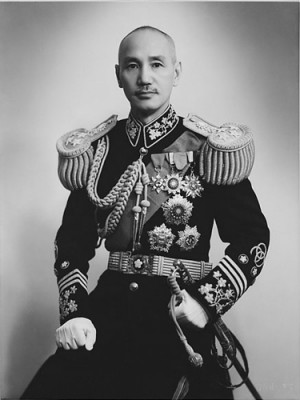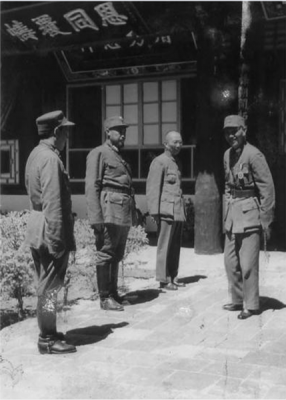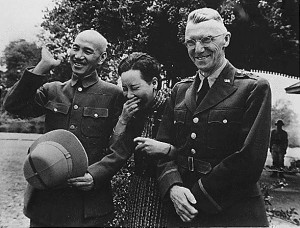There were several small wars that heralded World War II. One of them was the Spanish Civil War and another one was the war between Japan and China, both taking place in the late 1930s. Chiang Kai-shek was instrumental in the latter war.
Chiang Kai-shek (1887-1975) was the military and political leader of Nationalist China from the mid 1920s until 1949. He was the head of the Kuomintang Party, which was the Chinese Nationalist party that had overthrown the Manchu or Qing Dynasty and proclaimed China a republic in 1912.
Early Life
Chiang was born in the Zhejiang Province to affluent salt merchants. His father died when he was a child and he received a military education in China at the Baoding Military Academy and then Tokyo. He was also a soldier in the Imperial Japanese Army between 1909 and 1911.
It was in Japan where Chiang met Sun Yat-sen, the revolutionary leader who had overthrown the Manchu Dynasty. Chiang and Sun co-founded the Kuomintang, or KMT. On at least one occasion, Chiang saved Sun from assassination. Sun sent him to Russia in 1923 to study the Soviet model, though Chiang did not think this model was right for China. Russian communists had pledged to support the Nationalist Party and sent arms, money, and advisers, though they insisted that Sun accept the help of the Chinese Communists. When Chiang returned to China, Sun made him president of the Whampoa Military Academy. Sun Yat-sen died in 1925 and Chiang took command of the Nationalist Army the following year.
Rise of the Nationalists
In 1926, the Nationalist forces, along with their Communist colleagues, left Canton on a campaign against warlords in the north of the country. In March of 1927, the rebels captured Shanghai and the lower part of the Yangtze Valley. But the next month, Chiang turned against the Communists and purged many of their leaders. This caused the Communists to hide in the hills of the Kiangsi Province.
Also in 1927, Chiang established the capital in Nanking and married Soong Mei-Ling, one of the powerful daughters of Charles Soong. This made him a brother-in-law to Sun Yat-sen, who had married Mei-Ling’s sister Ching-Ling. Chiang converted to Christianity a while later. The next year he created the National Government of China.
When the warlords were defeated, the Nationalists became the dominant power in China, even though Russian advisers failed in their attempt to seize power at Shanghai and Hankow and were later expelled from the country. In June of 1928, Chiang’s rebels captured Beijing (then called Peking) and brought northern and southern China under the rule of one government.
From 1928 to 1937, Chiang Kai-shek bolstered the political and economic institutions in China. But he always had difficulty with political consolidation, as the Japanese military and the Chinese Communists conspired against his regime. In 1931, Japan occupied Manchuria, renamed it Manchukuo, and made it a puppet state. They had driven the Chinese armed forces from the Jehol Province, which they annexed to Manchukuo. After that, Japan demanded that China free five provinces from the North China Plain. This was happening even while the Nationalists and the Communists were battling in the south and west. Chiang gave in to the Japanese demand just to buy time in his fight against the Chinese Communists.
Still, by 1936, Japan was contemplating an all-out invasion of China. The Chinese Nationalists did not know whether to fight them or fight the Communists. In December, Chiang was arrested by his own Nationalist generals and imprisoned until he agreed to a truce with the Communists.
Japanese Invasion and World War II
The Japanese invasion of China in 1937 forced the Communists to ally with the Nationalists to repel them. Chiang assumed the position of generalissimo and was nicknamed “The Red General” by the Chinese and westerners alike. Though the Communists and the Nationalists fought valiantly together, the Japanese had already taken over much of Eastern China by 1939 and forced Chiang to move the capital from Nanking to Chungking. The one thing that kept Japan from conquering all of China was that they turned their attention to attacking the United States at Pearl Harbor on December 7, 1941. The day after that, China declared war on Germany and joined the Allies in World War II.
The Allies in turn lavished China with arms and other aid, though Japan cut off the sea lanes that led to China. A supply road, the famous Burma Road, was created to help China continue to receive supplies from the Allies. The supply road was successful until Japan conquered Burma. The Allies then flew supplies to China from bases in India. The Chinese, the British, and a few American forces fought in Burma and other places in Southeast Asia.
In 1943, the United States and the United Kingdom signed new treaties with China, which established China as a major world power. In November of 1943, Chiang met with President Franklin Roosevelt and Prime Minister Winston Churchill of the U.K. in Cairo. The three agreed that by the end of the war, Japan had to surrender all of the territory it had seized from China.
Japanese Surrender
In 1945, the Communists turned once again against Chiang as it looked like the Japanese defeat in World War II was inevitable. In response, Chiang drew up a new constitution and called for elections. He was elected the President of China, with Li Tsung-jen as co-president in 1948. But the Communists had popular support from the Chinese people and had their forces in many areas in China. The Russians, who had occupied Manchuria, gave the Communists many captured Japanese armaments to help them in their fight. On the other hand, the United States sent General George C. Marshall in an effort to arrange a truce between the Chinese Communists and the Nationalists, but his efforts failed.
In 1949, the Communists captured Nanking, which Chiang had again made the capital of the Nationalists. Chiang resigned and Li became president, but the Communists eventually prevailed. They drove Chiang and the Nationalist army from the mainland by the end of 1949.
Taiwan
Chiang and the Nationalists fled to Taiwan (then called Formosa), off the coast of mainland China in the China Sea, where Chiang was able to take military and civilian control. He made Taipei the capitol of the government and was elected president four times. During his presidency in Taiwan, Chiang never stopped planning to take mainland China back. He died in 1975.


